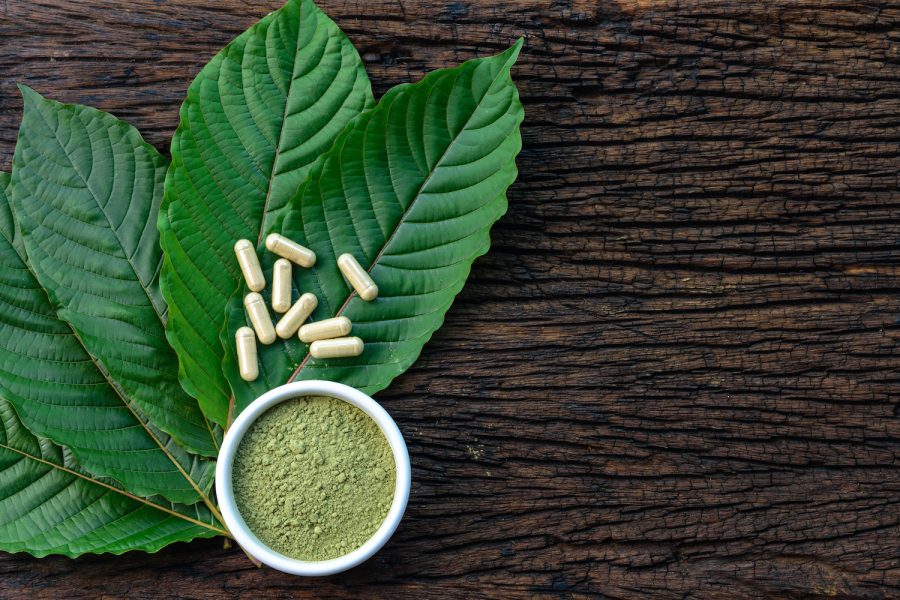It’s not cannabis and it’s not a poppy. It’s something entirely different and it traveled a long way from its original home in Asia all the way to your local smoke shop right around the corner and its name is “Kratom.”
Kratom, or its scientific name, Mitragyna speciosa, is a leaf grown on trees indigenous to southeastern regions in Asia like Myanmar. The plant contains the alkaloid Mitragynine and the chemical 7-hydroxymitragynine, which both target the opioid receptors in the brain causing similar effects of regular opioids. The difference is that Kratom obviously doesn’t derive from the poppy family but rather the coffee family of flowering plants.
Kratom comes in a variety of forms like capsules, powders, paste, and even raw leaves, so there are plenty of ways to ingest this plant.
But is it even legal? It depends. The psychoactive plant is technically not regulated on a federal level right now, but certain states have made it completely illegal like Alabama, Arkansas, Indiana, Rhode Island, Vermont and Wisconsin, according to sprouthealthgroup.com, while many other states have put in place certain regulations like age restrictions. In Texas, it is legal to buy, sell and consume Kratom.
While Kratom has garnered popularity in recent years among Americans, it’s been used in Southeast Asia for many years as a traditional medicine. According to a study examining the botanical properties of Kratom, laborers in Thailand sometimes ingest it to stave off exhaustion and as a painkiller.
“It’s unclear when Kratom use began, and, although we only have a couple centuries of documented Kratom use in Southeast Asia, the practice is thought to be ancient,” according to Bow Key Botanical, a Kratom and CBD distributing website discussing the plant’s history.
Though considered to be ancient, records and research of Kratom use date closer to only two centuries.
Pros
The effects of Kratom vary depending on the size of dosage taken; in smaller doses it gives a stimulating effect, the same effect you’d find when drinking any form of caffeine. At higher doses, kratom acts as a sedative (giving a high) in which recreational users claim can be used to treat pain, diarrhea, and even opiate withdrawals.
At first, Kratom offers useful effects in low doses, giving a psychedelic stimulus similar to coffee where one feels more awakened — almost like your regular cup of coffee.
Though recreational users across the U.S. rejoice in the treatments kratom offers, the FDA officially warns against taking it, but there aren’t any laws giving the agency any teeth to bite with.
“FDA is concerned that Kratom, which affects the same opioid brain receptors as morphine, appears to have properties that expose users to the risks of addiction, abuse, and dependence,” its website states.
Though not a party drug for getting kicks at a summer bash, the drug has different applications and forms it can be ingested, such as delicious teas and smoothies usually added with a sweetener. Or if you’re hardcore, you can just chew on the plant’s leaves.
Cons
The most immediate negative aspects of Kratom are its adverse side effects ranging from dizziness, nausea, vomiting, hangover, itchiness, and reduced sexual desire.
The dangers of Kratom are in debate as research is still on going about its safety parameters as some death-related incidents have occurred. “According to a new report from the U.S. Centers for Disease Control and Prevention, Kratom was determined to be a cause of death in 91 overdoses from July 2016 to December 2017,” Georgea Kovanis, a journalist that covers the opioid epidemic for the Detroit Free Press, wrote in an article about Kratom. “In seven of those deaths, Kratom was the only substance detected in toxicology test, though the CDC said it couldn’t rule out other substances might be present.”
Kratom’s legal status has been debates nationwide in recent years, but in 2016, the substance was spared from being outlawed by the DEA.
There is still debate about the application of kratom, whether it can be used as an opium substitute or not, as it has been used more for recreation than for practical purposes like pain management or for diarrhea.
What gives the drug a bad rap is the “4×100” kratom cocktail that originated in southern Thailand which is a drink made up of only four components; kratom, Coca-Cola, cough syrup, and ice.
Opinion
I had first learned of Kratom while watching Hamilton’s Pharmacopeia alongside my fiancé one evening. Naturally, we second guessed much of the information presented to us as it sounded too good to be true.
With a little research and a lot of Googling, it wasn’t until I drove down the street and saw a sign advertising Kratom, so I decided to check it out myself.
After purchasing a small $15 jar of green “White Maeng Da” Indonesian Kratom powder, I have still yet to try it because of the massive controversy around it.
I personally believe in the power of herbal medicine over processed pharmaceutical drugs, but 2020 is by far a different year regarding medicine with so many being killed by the COVID-19 disease.
Like FDA, I don’t think ingesting Kratom daily is a bright idea, nor do I suggest the 4×100 drink because that may be a recipe for death. But I’m not ready to throw my unopened jar of Kratom just yet.
In conclusion, there are pros and there are cons, like with everything else. Do your research but try it at your own risk.
Sven Kline may be reached at [email protected]; @SvenKline on Twitter.










